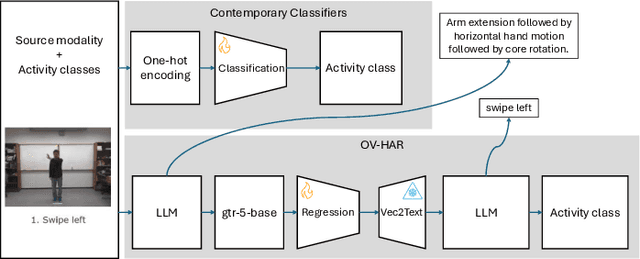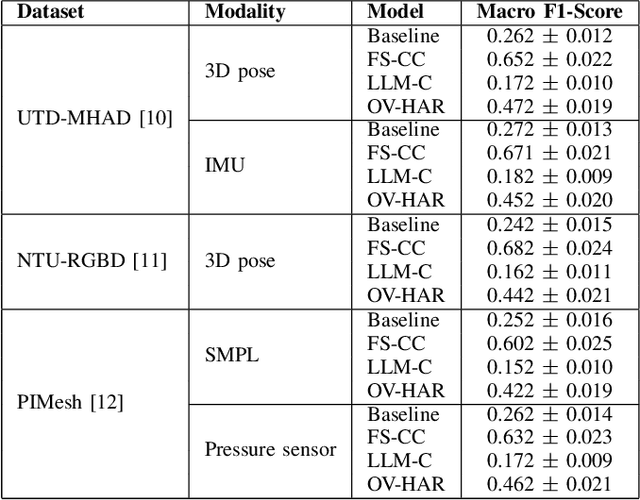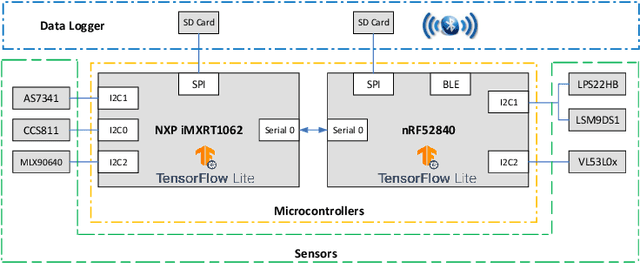Sungho Suh
SImpHAR: Advancing impedance-based human activity recognition using 3D simulation and text-to-motion models
Jul 08, 2025Abstract:Human Activity Recognition (HAR) with wearable sensors is essential for applications in healthcare, fitness, and human-computer interaction. Bio-impedance sensing offers unique advantages for fine-grained motion capture but remains underutilized due to the scarcity of labeled data. We introduce SImpHAR, a novel framework addressing this limitation through two core contributions. First, we propose a simulation pipeline that generates realistic bio-impedance signals from 3D human meshes using shortest-path estimation, soft-body physics, and text-to-motion generation serving as a digital twin for data augmentation. Second, we design a two-stage training strategy with decoupled approach that enables broader activity coverage without requiring label-aligned synthetic data. We evaluate SImpHAR on our collected ImpAct dataset and two public benchmarks, showing consistent improvements over state-of-the-art methods, with gains of up to 22.3% and 21.8%, in terms of accuracy and macro F1 score, respectively. Our results highlight the promise of simulation-driven augmentation and modular training for impedance-based HAR.
TxP: Reciprocal Generation of Ground Pressure Dynamics and Activity Descriptions for Improving Human Activity Recognition
May 04, 2025Abstract:Sensor-based human activity recognition (HAR) has predominantly focused on Inertial Measurement Units and vision data, often overlooking the capabilities unique to pressure sensors, which capture subtle body dynamics and shifts in the center of mass. Despite their potential for postural and balance-based activities, pressure sensors remain underutilized in the HAR domain due to limited datasets. To bridge this gap, we propose to exploit generative foundation models with pressure-specific HAR techniques. Specifically, we present a bidirectional Text$\times$Pressure model that uses generative foundation models to interpret pressure data as natural language. TxP accomplishes two tasks: (1) Text2Pressure, converting activity text descriptions into pressure sequences, and (2) Pressure2Text, generating activity descriptions and classifications from dynamic pressure maps. Leveraging pre-trained models like CLIP and LLaMA 2 13B Chat, TxP is trained on our synthetic PressLang dataset, containing over 81,100 text-pressure pairs. Validated on real-world data for activities such as yoga and daily tasks, TxP provides novel approaches to data augmentation and classification grounded in atomic actions. This consequently improved HAR performance by up to 12.4\% in macro F1 score compared to the state-of-the-art, advancing pressure-based HAR with broader applications and deeper insights into human movement.
Initial Findings on Sensor based Open Vocabulary Activity Recognition via Text Embedding Inversion
Jan 13, 2025

Abstract:Conventional human activity recognition (HAR) relies on classifiers trained to predict discrete activity classes, inherently limiting recognition to activities explicitly present in the training set. Such classifiers would invariably fail, putting zero likelihood, when encountering unseen activities. We propose Open Vocabulary HAR (OV-HAR), a framework that overcomes this limitation by first converting each activity into natural language and breaking it into a sequence of elementary motions. This descriptive text is then encoded into a fixed-size embedding. The model is trained to regress this embedding, which is subsequently decoded back into natural language using a pre-trained embedding inversion model. Unlike other works that rely on auto-regressive large language models (LLMs) at their core, OV-HAR achieves open vocabulary recognition without the computational overhead of such models. The generated text can be transformed into a single activity class using LLM prompt engineering. We have evaluated our approach on different modalities, including vision (pose), IMU, and pressure sensors, demonstrating robust generalization across unseen activities and modalities, offering a fundamentally different paradigm from contemporary classifiers.
OV-HHIR: Open Vocabulary Human Interaction Recognition Using Cross-modal Integration of Large Language Models
Dec 31, 2024



Abstract:Understanding human-to-human interactions, especially in contexts like public security surveillance, is critical for monitoring and maintaining safety. Traditional activity recognition systems are limited by fixed vocabularies, predefined labels, and rigid interaction categories that often rely on choreographed videos and overlook concurrent interactive groups. These limitations make such systems less adaptable to real-world scenarios, where interactions are diverse and unpredictable. In this paper, we propose an open vocabulary human-to-human interaction recognition (OV-HHIR) framework that leverages large language models to generate open-ended textual descriptions of both seen and unseen human interactions in open-world settings without being confined to a fixed vocabulary. Additionally, we create a comprehensive, large-scale human-to-human interaction dataset by standardizing and combining existing public human interaction datasets into a unified benchmark. Extensive experiments demonstrate that our method outperforms traditional fixed-vocabulary classification systems and existing cross-modal language models for video understanding, setting the stage for more intelligent and adaptable visual understanding systems in surveillance and beyond.
Beyond Confusion: A Fine-grained Dialectical Examination of Human Activity Recognition Benchmark Datasets
Dec 12, 2024



Abstract:The research of machine learning (ML) algorithms for human activity recognition (HAR) has made significant progress with publicly available datasets. However, most research prioritizes statistical metrics over examining negative sample details. While recent models like transformers have been applied to HAR datasets with limited success from the benchmark metrics, their counterparts have effectively solved problems on similar levels with near 100% accuracy. This raises questions about the limitations of current approaches. This paper aims to address these open questions by conducting a fine-grained inspection of six popular HAR benchmark datasets. We identified for some parts of the data, none of the six chosen state-of-the-art ML methods can correctly classify, denoted as the intersect of false classifications (IFC). Analysis of the IFC reveals several underlying problems, including ambiguous annotations, irregularities during recording execution, and misaligned transition periods. We contribute to the field by quantifying and characterizing annotated data ambiguities, providing a trinary categorization mask for dataset patching, and stressing potential improvements for future data collections.
RAD: Region-Aware Diffusion Models for Image Inpainting
Dec 12, 2024Abstract:Diffusion models have achieved remarkable success in image generation, with applications broadening across various domains. Inpainting is one such application that can benefit significantly from diffusion models. Existing methods either hijack the reverse process of a pretrained diffusion model or cast the problem into a larger framework, \ie, conditioned generation. However, these approaches often require nested loops in the generation process or additional components for conditioning. In this paper, we present region-aware diffusion models (RAD) for inpainting with a simple yet effective reformulation of the vanilla diffusion models. RAD utilizes a different noise schedule for each pixel, which allows local regions to be generated asynchronously while considering the global image context. A plain reverse process requires no additional components, enabling RAD to achieve inference time up to 100 times faster than the state-of-the-art approaches. Moreover, we employ low-rank adaptation (LoRA) to fine-tune RAD based on other pretrained diffusion models, reducing computational burdens in training as well. Experiments demonstrated that RAD provides state-of-the-art results both qualitatively and quantitatively, on the FFHQ, LSUN Bedroom, and ImageNet datasets.
Spend More to Save More (SM2): An Energy-Aware Implementation of Successive Halving for Sustainable Hyperparameter Optimization
Dec 11, 2024


Abstract:A fundamental step in the development of machine learning models commonly involves the tuning of hyperparameters, often leading to multiple model training runs to work out the best-performing configuration. As machine learning tasks and models grow in complexity, there is an escalating need for solutions that not only improve performance but also address sustainability concerns. Existing strategies predominantly focus on maximizing the performance of the model without considering energy efficiency. To bridge this gap, in this paper, we introduce Spend More to Save More (SM2), an energy-aware hyperparameter optimization implementation based on the widely adopted successive halving algorithm. Unlike conventional approaches including energy-intensive testing of individual hyperparameter configurations, SM2 employs exploratory pretraining to identify inefficient configurations with minimal energy expenditure. Incorporating hardware characteristics and real-time energy consumption tracking, SM2 identifies an optimal configuration that not only maximizes the performance of the model but also enables energy-efficient training. Experimental validations across various datasets, models, and hardware setups confirm the efficacy of SM2 to prevent the waste of energy during the training of hyperparameter configurations.
Past, Present, and Future of Sensor-based Human Activity Recognition using Wearables: A Surveying Tutorial on a Still Challenging Task
Nov 11, 2024Abstract:In the many years since the inception of wearable sensor-based Human Activity Recognition (HAR), a wide variety of methods have been introduced and evaluated for their ability to recognize activities. Substantial gains have been made since the days of hand-crafting heuristics as features, yet, progress has seemingly stalled on many popular benchmarks, with performance falling short of what may be considered 'sufficient'-- despite the increase in computational power and scale of sensor data, as well as rising complexity in techniques being employed. The HAR community approaches a new paradigm shift, this time incorporating world knowledge from foundational models. In this paper, we take stock of sensor-based HAR -- surveying it from its beginnings to the current state of the field, and charting its future. This is accompanied by a hands-on tutorial, through which we guide practitioners in developing HAR systems for real-world application scenarios. We provide a compendium for novices and experts alike, of methods that aim at finally solving the activity recognition problem.
A Wearable Multi-Modal Edge-Computing System for Real-Time Kitchen Activity Recognition
Sep 10, 2024



Abstract:In the human activity recognition research area, prior studies predominantly concentrate on leveraging advanced algorithms on public datasets to enhance recognition performance, little attention has been paid to executing real-time kitchen activity recognition on energy-efficient, cost-effective edge devices. Besides, the prevalent approach of segregating data collection and context extraction across different devices escalates power usage, latency, and user privacy risks, impeding widespread adoption. This work presents a multi-modal wearable edge computing system for human activity recognition in real-time. Integrating six different sensors, ranging from inertial measurement units (IMUs) to thermal cameras, and two different microcontrollers, this system achieves end-to-end activity recognition, from data capture to context extraction, locally. Evaluation in an unmodified realistic kitchen validates its efficacy in recognizing fifteen activities, including a null class. Employing a compact machine learning model (184.5 kbytes) yields an average accuracy of 87.83 \%, with model inference completed in 25.26 ms on the microcontroller. Comparative analysis with alternative microcontrollers showcases power consumption and inference speed performance, demonstrating the proposed system's viability.
TSAK: Two-Stage Semantic-Aware Knowledge Distillation for Efficient Wearable Modality and Model Optimization in Manufacturing Lines
Aug 26, 2024



Abstract:Smaller machine learning models, with less complex architectures and sensor inputs, can benefit wearable sensor-based human activity recognition (HAR) systems in many ways, from complexity and cost to battery life. In the specific case of smart factories, optimizing human-robot collaboration hinges on the implementation of cutting-edge, human-centric AI systems. To this end, workers' activity recognition enables accurate quantification of performance metrics, improving efficiency holistically. We present a two-stage semantic-aware knowledge distillation (KD) approach, TSAK, for efficient, privacy-aware, and wearable HAR in manufacturing lines, which reduces the input sensor modalities as well as the machine learning model size, while reaching similar recognition performance as a larger multi-modal and multi-positional teacher model. The first stage incorporates a teacher classifier model encoding attention, causal, and combined representations. The second stage encompasses a semantic classifier merging the three representations from the first stage. To evaluate TSAK, we recorded a multi-modal dataset at a smart factory testbed with wearable and privacy-aware sensors (IMU and capacitive) located on both workers' hands. In addition, we evaluated our approach on OpenPack, the only available open dataset mimicking the wearable sensor placements on both hands in the manufacturing HAR scenario. We compared several KD strategies with different representations to regulate the training process of a smaller student model. Compared to the larger teacher model, the student model takes fewer sensor channels from a single hand, has 79% fewer parameters, runs 8.88 times faster, and requires 96.6% less computing power (FLOPS).
 Add to Chrome
Add to Chrome Add to Firefox
Add to Firefox Add to Edge
Add to Edge